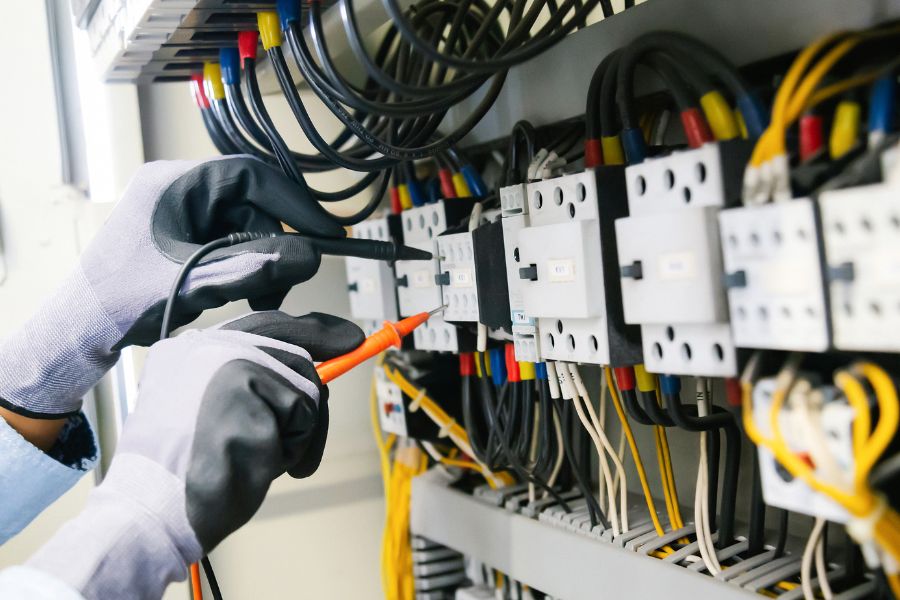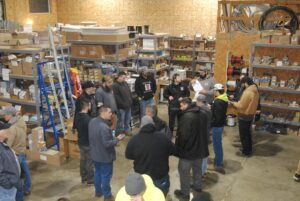
Electricity powers our modern lives, from morning alarms to late-night streaming sessions. Yet, this invisible force, when mishandled, can cause catastrophic damage. Electrical shocks, fires, and appliance malfunctions are often the result of faulty wiring or improper installations. Thankfully, a small yet mighty device exists to mitigate these risks: the Ground-Fault Interrupter (GFI).
GFI installation is more than a code requirement—it’s a frontline defense against electrical hazards. Whether you’re remodeling a bathroom, upgrading a kitchen, or installing outdoor outlets, understanding the significance of GFI devices can safeguard your home and loved ones from potentially life-threatening situations.
What is GFI and How Does it Work?
A Ground-Fault Interrupter (GFI), often referred to as a GFCI (Ground-Fault Circuit Interrupter), is a safety device designed to protect individuals from electrical shocks. It continuously monitors the flow of electricity through a circuit and shuts off power if it detects an imbalance.
The Science Behind GFI Protection:
Electricity typically flows in a balanced loop between the hot and neutral wires. If a ground fault occurs—meaning electricity escapes the intended path and travels through an unintended conductor like water or a human—the GFI senses this irregularity and cuts power within milliseconds.
Example:
Imagine a hairdryer falling into a water-filled sink. A properly installed GFI outlet will immediately shut off power, preventing electric shock.
Why GFI Installation is Essential for Your Home
The importance of GFI installation extends beyond code compliance. It’s about ensuring a safe and secure living environment. Here’s why every homeowner should prioritize GFI installation:
1. Prevents Electric Shocks
Water and electricity don’t mix well. Kitchens, bathrooms, outdoor areas, and laundry rooms are particularly susceptible to ground faults due to moisture exposure. GFIs reduce the risk of shock in these high-risk zones.
2. Reduces the Risk of Electrical Fires
Electrical fires often start when current leaks to unintended surfaces. GFIs detect these leaks early and cut power, mitigating fire hazards.
Fact:
The Electrical Safety Foundation International (ESFI) reports that ground faults cause hundreds of electrical fires each year in the U.S.
3. Ensures Code Compliance
Building codes, including the National Electrical Code (NEC), mandate GFI outlets in specific areas. Proper installation not only enhances safety but also ensures you pass home inspections effortlessly.
4. Protects Appliances and Devices
Electric current leaks can damage sensitive electronics. GFIs help preserve the lifespan of household appliances by preventing electrical fluctuations.
5. Increases Property Value
Homes with updated electrical systems, including GFI-protected outlets, are more appealing to potential buyers.
Key Areas Requiring GFI Installation
GFIs are critical wherever water and electricity might intersect. The NEC specifies several locations where these devices are mandatory.
1. Bathrooms
Water-laden environments increase the likelihood of ground faults. GFIs are required for all outlets within six feet of a water source.
2. Kitchens
Kitchen outlets near sinks, dishwashers, and countertops need GFI protection due to potential water splashes and appliance malfunctions.
- Outdoor Areas
Outdoor outlets are exposed to rain, snow, and humidity. GFIs prevent electrical hazards from garden tools, decorative lighting, and irrigation systems.
4. Laundry and Utility Rooms
Washing machines and utility sinks create moisture-rich conditions that demand reliable GFI protection.
- Pools, Hot Tubs, and Spas
Electrical equipment for pools, spas, and hot tubs must be protected with GFIs to prevent water-related shocks.
6. Garages and Basements
Moisture from concrete floors and outdoor tools necessitates GFI outlets in these areas.
The GFI Installation Process: Step-by-Step
Proper GFI installation requires precision and adherence to safety protocols. Here’s a step-by-step breakdown of the process:
1. Power Shutdown
- Turn off power to the circuit at the main electrical panel.
- Use a voltage tester to confirm the circuit is inactive.
2. Outlet Removal
- Remove the faceplate and unscrew the existing outlet.
- Pull the outlet from the electrical box while ensuring wires remain intact.
3. Wire Identification
- Identify the line (incoming power) and load (downstream protection) wires.
- GFIs rely on accurate wiring for proper functionality.
Pro Tip:
Line wires connect to terminals labeled “Line,” while load wires connect to terminals labeled “Load” for downstream GFI protection.
4. Device Installation
- Connect wires to the correct terminals: black (hot) to brass, white (neutral) to silver, and green (ground) to the grounding screw.
- Secure the GFI outlet in the electrical box and reattach the faceplate.
5. Testing and Verification
- Restore power and press the “Test” and “Reset” buttons on the GFI to confirm proper operation.
- Use a GFI tester for an additional layer of verification.
Common Mistakes to Avoid During GFI Installation
Even minor errors can compromise GFI functionality and safety. Here are common pitfalls and how to avoid them:
1. Incorrect Wire Connections
Reversing line and load wires disables the GFI’s protective capabilities.
2. Neglecting Grounding
A GFI can still function without a ground connection but won’t provide optimal safety. Grounding is essential for directing fault currents safely.
3. Using Standard Outlets in Wet Locations
Ordinary outlets offer no shock protection in moisture-prone areas. Always install GFI outlets in kitchens, bathrooms, and outdoor spaces.
4. Overloading Circuits
Connecting too many devices to a single GFI circuit can cause nuisance tripping. Distribute loads evenly across multiple outlets.
Tip:
Dedicated circuits for appliances like refrigerators prevent performance issues.
GFI vs. AFCI: Understanding the Difference
GFI (Ground-Fault Interrupter) and AFCI (Arc-Fault Circuit Interrupter) serve different purposes but are equally essential.
Ground-Fault Interrupter (GFI)
- Protects against ground faults by shutting off power when electricity escapes its intended path.
- Essential for moisture-prone areas like kitchens and bathrooms.
Arc-Fault Circuit Interrupter (AFCI)
- Detects dangerous electrical arcs, which can ignite fires.
- Required in living rooms, bedrooms, and other dry areas.
Insight:
Modern electrical panels often combine GFI and AFCI protection in one device.
Energy Efficiency and GFI Technology
While primarily a safety device, GFI technology has evolved to incorporate energy-efficient features.
Energy-Saving Innovations:
- Smart GFIs: Monitor usage patterns and optimize power delivery.
- LED Indicators: Provide clear status updates, reducing unnecessary troubleshooting.
- Wi-Fi Integration: Smart GFIs allow remote monitoring through home automation systems.
Did You Know?
Modern GFIs can detect electrical leaks as small as 5 milliamps—far below shock-inducing levels.
The Dangers of Ignoring GFI Installation
Electrical safety isn’t a luxury; it’s a necessity. Failing to install GFI outlets where required exposes your home and family to preventable risks.
Potential Consequences of Neglecting GFI Installation:
- Electric Shock: Direct contact with energized water can cause severe injury or death.
- Electrical Fires: Ground faults can ignite wiring and nearby flammable materials.
- Code Violations: Non-compliant electrical systems may lead to failed inspections, fines, or complications when selling your home.
Case Study:
A Florida homeowner experienced repeated shocks from a faulty outdoor outlet. An inspection revealed a lack of GFI protection, which allowed current leakage into the patio area. A simple GFI installation resolved the issue and restored safety.
Maintenance Tips for GFI Outlets
Like any safety device, GFI outlets require periodic maintenance to function reliably.
🔍 GFI Maintenance Checklist:
- Test Monthly: Press the “Test” button to ensure the device trips and cuts power.
- Inspect for Damage: Check for cracks, discoloration, or buzzing noises.
- Keep Outlets Dry: Water-resistant covers protect outdoor GFIs from moisture.
- Replace Faulty Units: GFIs that fail to reset or test properly should be replaced immediately.
Pro Tip:
Use a GFI outlet tester, available at most hardware stores, to verify correct wiring and functionality.
FAQ Section
1. How does a GFI protect me from electrical shock?
A GFI detects ground faults by monitoring electrical current flow. If current escapes the circuit, the device instantly shuts off power to prevent shock.
2. Where should GFI outlets be installed?
The NEC requires GFI outlets in kitchens, bathrooms, laundry rooms, outdoor areas, garages, and any location near water sources.
3. Can I install a GFI outlet myself?
While DIY installation is possible, hiring a licensed electrician ensures proper wiring, code compliance, and long-term safety.
4. How often should GFI outlets be tested?
Test GFI outlets monthly to verify their protective function. Press the “Test” button; if the power doesn’t cut, replace the device.
5. Are GFI and GFCI outlets the same?
Yes. GFI and GFCI are interchangeable terms describing ground-fault protection devices.
Electricity is indispensable in modern life—but only when managed safely. GFI installation is a simple yet vital measure that protects against shocks, fires, and costly damage. Don’t leave your family’s safety to chance.
Our expert electricians bring precision, experience, and adherence to the latest safety standards, ensuring every GFI outlet functions flawlessly. Whether upgrading an older home or installing new circuits, we’ve got you covered.







